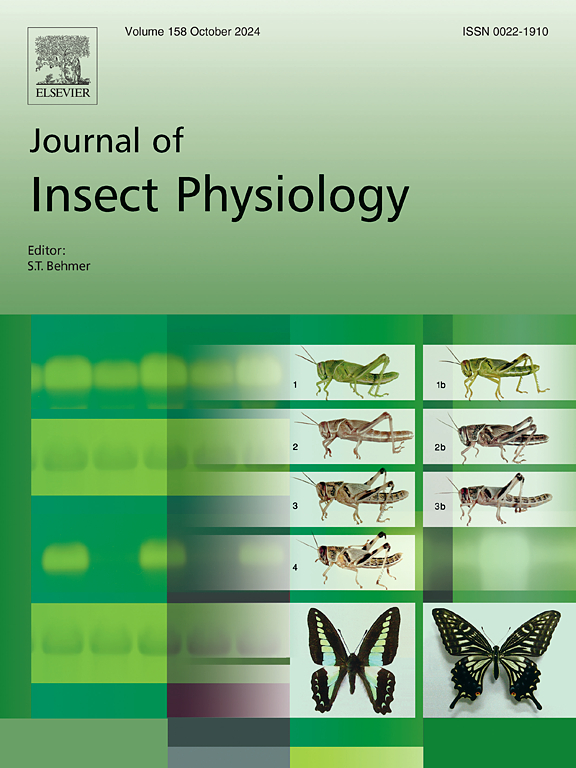Do bumble bees make optimal nutritional choices?
IF 2.3
2区 农林科学
Q1 ENTOMOLOGY
引用次数: 0
Abstract
Nutrition is crucial for bees, impacting their health, survival, and pollination performance in ecosystems and agriculture. Bees get essential nutrients such as carbohydrates, proteins, lipids, vitamins, and minerals, primarily from nectar and pollen. Many bee species are experiencing declines linked partially to nutritional stress, often exacerbated by climate change, pesticides, and pathogens, highlighting the need to understand and support optimal bee nutrition to mitigate these stressors. Bumble bees, such as Bombus impatient and Bombus terrestris, essential pollinators in agriculture, are known to regulate their nutrient intake. However, whether their dietary choices improve fitness is poorly understood. We tested diets with varying protein, lipid, and carbohydrate compositions, analyzing impacts on consumption, body mass, egg laying, and ovarian activation. Results showed that bees overconsumed pollen on protein-enriched diets and under consumed it on lipid-enriched and glucose-based diets. Nectar overconsumption was observed on low-concentration sucrose diets. These patterns, however, did not correspond to improved fitness, as egg laying and body mass were negatively correlated with consumption in diets enriched with protein and sugar. Ovarian activation was largely unaffected across most diets, indicating it may not be a reliable indicator of diet quality. These findings raise doubts about whether bees make optimal nutritional choices and suggest that diet consumption alone may not be a reliable indicator of their optimal diet. Alternatively, bees made the best possible decisions under circumstances that presented a lose-lose tradeoff across all the diets provided. These data can inform future studies on nutritional stress, enhance interpretations of bee diet preferences in bioassays, and guide bumble bee management practices.

大黄蜂能做出最佳的营养选择吗?
营养对蜜蜂至关重要,影响它们在生态系统和农业中的健康、生存和授粉表现。蜜蜂主要从花蜜和花粉中获取必需的营养物质,如碳水化合物、蛋白质、脂类、维生素和矿物质。许多蜜蜂物种正在经历与营养压力部分相关的衰退,而营养压力往往因气候变化、杀虫剂和病原体而加剧,这凸显了了解和支持最佳蜜蜂营养以减轻这些压力源的必要性。大黄蜂(Bombus不耐烦和Bombus terrestris)是农业中必不可少的传粉者,它们调节自己的营养摄入。然而,人们对他们的饮食选择是否能改善健康状况知之甚少。我们测试了含有不同蛋白质、脂质和碳水化合物成分的饮食,分析了对摄入量、体重、产蛋量和卵巢活性的影响。结果表明,蜜蜂在富含蛋白质的饮食中过量摄入花粉,而在富含脂肪和葡萄糖的饮食中摄入花粉不足。在低浓度蔗糖饲粮中观察到花蜜过度消耗。然而,这些模式并不与健康状况的改善相对应,因为产蛋量和体重与富含蛋白质和糖的饮食摄入量呈负相关。卵巢激活在大多数饮食中基本上没有受到影响,这表明它可能不是饮食质量的可靠指标。这些发现引发了人们对蜜蜂是否会做出最佳营养选择的质疑,并表明饮食消耗本身可能不是蜜蜂最佳饮食的可靠指标。或者,蜜蜂在所有提供的饮食中呈现双输权衡的情况下做出了最好的决定。这些数据可以为未来的营养应激研究提供信息,增强生物测定中对蜜蜂饮食偏好的解释,并指导大黄蜂的管理实践。
本文章由计算机程序翻译,如有差异,请以英文原文为准。
求助全文
约1分钟内获得全文
求助全文
来源期刊

Journal of insect physiology
生物-昆虫学
CiteScore
4.50
自引率
4.50%
发文量
77
审稿时长
57 days
期刊介绍:
All aspects of insect physiology are published in this journal which will also accept papers on the physiology of other arthropods, if the referees consider the work to be of general interest. The coverage includes endocrinology (in relation to moulting, reproduction and metabolism), pheromones, neurobiology (cellular, integrative and developmental), physiological pharmacology, nutrition (food selection, digestion and absorption), homeostasis, excretion, reproduction and behaviour. Papers covering functional genomics and molecular approaches to physiological problems will also be included. Communications on structure and applied entomology can be published if the subject matter has an explicit bearing on the physiology of arthropods. Review articles and novel method papers are also welcomed.
 求助内容:
求助内容: 应助结果提醒方式:
应助结果提醒方式:


